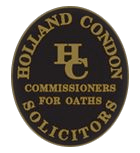Many of us enjoy rights of way without ever really thinking about them, for example, you may access your house or land through a neighbour’s private lane or roadway.
You do not own the private lane or roadway, it is not a public route maintained by the local authority, but you are entitled to use it, because you have a legal property right.
Where a right of way is expressly granted in a document, the route would usually be mapped, and the right of way would typically be registered.
Often, and as is the case with most lanes in Ireland, a right of way would be used for a very long time, but would not be registered anywhere or granted in a written document.
The Land and Conveyancing Law Reform Act 2009 changed the law in relation to the length of time needed to establish a right of way, and provides for a new user period of 12 years (previously 20 years).
After December 1, 2021, all unregistered rights of way shall only be acquired (by prescription only) on registration of a court order, or via the procedure for an uncontested registration of rights as per the Land Registry Rules.
In an action to establish or dispute the acquisition of the right of way, the court will only acknowledge a right of way if the person has used the right of way without interruption for at least 12 years up to that date. This increases to 30 years in the case of a right through State property, and 60 years in the case of a foreshore.
It is, therefore, advisable to contact your solicitor, who will advise you in relation to the circumstances of your situation.




